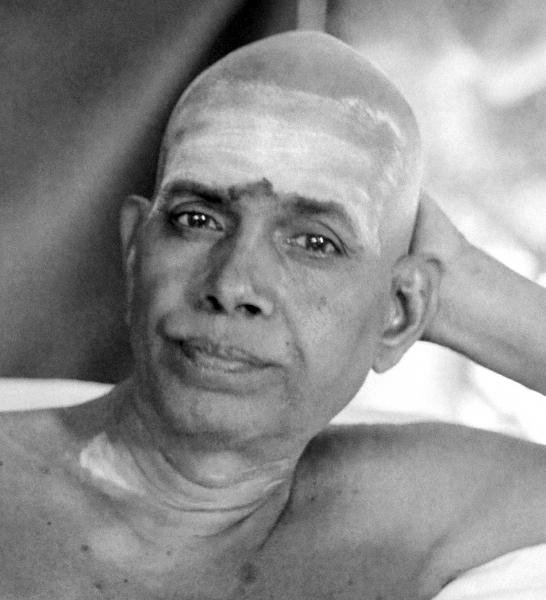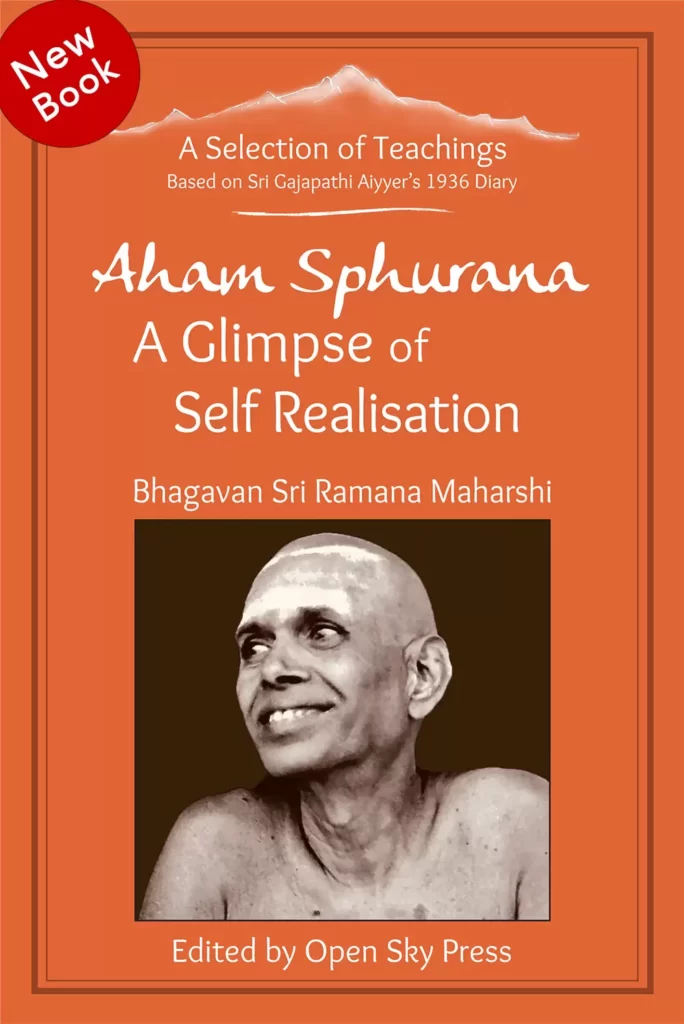
Aham Sphurana
A Glimpse of Self Realisation
New Book about Sri Ramana Maharshi

Available Worldwide
On www.openskypress.com and Amazon:

“In my opinion, Aham Sphurana, a Glimpse of Self Realisation, will become a Treasure Trove of Wisdom to the Seekers of Truth in general, and particularly to the devotees of Bhagavan.”
Swami Hamsananda – Athithi Ashram, Tiruvannamalai
A Typical Western Visitor’s
In-Depth Dialogue with Bhagavan
Time and again I have observed that the Maharshi emphasises that Realisation was more the result of Guru’s Grace rather than anything else. I had been in despair of ever again getting the Maharshi alone. It is hard to unburden the soul before a crowd.
One morning I resolutely made my way into the Hall a few hours earlier than usualand found him there unattended, emanating his usual wonderful stillness and ineffable peace. I asked quietly if I might talk with him. He nodded, smiling, and sent for someone to translate. On the arrival of a devotee, I put my first question.
Q: What are the obstacles which hinder Realisation of the Self?
B.: They are habits of mind (vasanas).
Q: How to overcome these mental habits?
B.: By Realising the Self.
Q: That is a vicious circle.
B.: It is the mind which brings about such difficulties, creating obstacles and then suffering from the perplexity of apparent paradoxes. Find out who makes the enquiries and the Self will be found.
Q: What are the aids for Realisation?
B.: Introversion of mind is the one and only aid.
Q.: How can I achieve the same?
B.: By preventing the mind from straying out after thoughts, desires and imagined objects of sensory perception.
Q.: If the world is a dream, am I making efforts to Realise the Self within a dream?
B.: Yes.
Q.: But there will always be other dreams! Do we have to make efforts to Realise within each and every dream?
B.: If effort is going on to Realise the Self within this dream, it means that the same effort is going on within all other dreams also.
Q.: Discussions, lectures and meditations: are they not useful for attaining Realisation?
B.: All these are only secondary aids, whereas the essential aid is Guru’s Grace.
Q: How long will it take for one to get Realisation?
B.: Why do you desire to know?
Q: To give me hope.
M.: Such a desire is also an obstacle. The Self is ever there, there is nothing without it. Be the Self and the desires and doubts will disappear. The Self is the witness in sleep, dream and waking states of existence. These states belong to the ego. The Self transcends the ego. Ego or no ego, the Self remains always. It is ever as It is. Did you not exist in sleep? Did you know then that you were asleep?Was there awareness of the world in sleep? In sleep you remained without a body and without a world. Why do you now hanker after these? In jagrat [watchfulness] you also remain aloof from body and world. It is only in jagrat that you describe the experience of sleep as being unawareness; therefore, the consciousness when asleep is the same as that when awake.
If you know what this waking consciousness is, you will know the consciousness that witnesses all the three states; such absolute consciousness is found by means of seeking the source of pure consciousness.
Q: In attempting to trace back pure consciousness to its source, I am overwhelmed by sleep and soon fall into slumber.
B.: No harm!
Q: I still maintain that to me sleep is nothing but a mere blank.
B.: For whom is the blank? Find out. You cannot deny your existence at any time. The Self is ever there and continues in all states.
Q: Should I remain as if in sleep and be watchful at the same time?
B.: Yes. Alert watchfulness is the true waking state. Therefore, the state of jagrat-sushupti [waking deep sleep] will not be one of sleep, but sleepless sleep.
If you go the way of your thoughts you will be carried away by them and you will find yourself in an endless maze.
Q: So, then, I must go back, tracing the source of thoughts.
B.: Quite so; in that way the thoughts will disappear and the Self alone will remain.
Q.: Does the practice ‘Who am I?’ lead to any spot inside the body?
B.: There is no inside or outside for the Self. These concepts are merely mental projections of the ego. The Self is pure and absolute. However, till Realisation is gained, it may be said that consciousness has a locus in the body, which is located on the right-hand side of the chest.
Q.: Is not intellect a help for Realisation?
B.: Yes, up to a certain stage. Even so, realise that the Self transcends the intellect; the latter must itself vanish in order that the Self might be Realised.
Q: Does my Realisation help others?
B.: Yes, certainly. It is the best help possible. However, the actual truth is that there are no others to be helped, for an Emancipated soul sees only the Self in everything, just like a goldsmith estimating the gold in various jewels sees gold and nothing but gold. When you identify yourself with the body, forms and shapes are to be found. But when you transcend your body the others in the world disappear along with your body-consciousness.
Q: Is it so with plants, trees, et cetera?
B.: Do they exist at all apart from the Self? Find out. You think that you see them. The thought is projected out from the mind. Find out from where the mind rises. Thoughts will cease to rise and the Self alone will remain.
Q: I understand theoretically. But thoughts refuse to subside.
B.: Thought is nothing but mental effervescence. Mind is only a bubble floating on the Self. Break the bubble and you are the ocean.
Q.: Is it the mind that creates the world we see?
B.: Yes. It is like a cinema show. There is the light on the screen and the shadows flitting across impress the audience as the enactment of some screenplay. If in the same screenplay an audience also is shown, what is the position? The seer and the seen will then only be the screen. Apply this analogy to yourself. You are the screen, the Self has created the ego, and the ego has its accretions of thoughtswhich are displayed as the world, the trees, plants, et cetera about which you are asking.
The truth is that all these are nothing but the Self. If you see the Self, the same will be found to be all, everywhere and always. Nothing but the Self exists.
Q: Yes, but I still understand only theoretically. Yet the answers are simple, beautiful and convincing.
B.: Even the thought, “I do not Realise.” is a hindrance. The Self alone IS and He alone could ever BE.
Q.: What are vasanas?
B.: Habits of thought, accumulated tendencies of mind, and intellectual proclivities.
Q.: How does one get rid of these hindrances?
B.: Seek the Self through meditation in this manner: trace every thought back to its point of origin, which is only the mind. Never allow thought to run on. If you do so, it will be unending. Take it back to its starting place — the mind’s essence of pure consciousness — again and again, and thought and thinker will both die of inaction eventually.
The mind only exists by reason of thought. Stop thought and there is no mind. As each doubt or depressing thought arises, ask yourself, “Who is it that doubts? What is it that is depressed?”. Go back constantly to the question, “Who or what is this thing called ‘I’? Where is the source of the mind?” Tear everything out and go on discarding until there is nothing but the Source of all left. And then live always in That and only in it.
There is no past or future, save in the mind. Only present exists. Yes, even the present is mere imagination. It IS. That is all. Ehyeh Asher Ehyeh. [I am that I am]
Q.: How can I help another with his or her problems and troubles?
B.: What is this talk of another? There is only the One. Try and realise there is no ‘I’ no ‘he’ no ‘you’, only the One Self which is all. If you believe in the problem of another, you are believing in something outside the Self. You will help him better by realising the oneness of everything than by any outward activity. The ego masks the Reality.
All mental activities during the states of jagrat and swapna [dream] are thehandiwork of the ego only. The emotions and intellect are merely mind-manufactured fictions. In deep sleep the body is lost, but yet the Self is there. It is the distracting, active mind that veils the real Self.
Q.: What meditation will help me?
B.: No meditation on any kind of object is helpful. You must learn to realise the subject and object as one. In meditating on an object, whether concrete or abstract, you are destroying the sense of oneness and creating duality.
Meditate on what you are in Reality. Try to realise that the body is not you, the emotions are not you, and the intellect is not you. When all these stand discarded you will find That.
Q.: What is ‘That’?
B.: You will discover it yourself. It is not for me to say what any individual experience ought to be. ‘That’ will reveal Itself to the mature aspirant automatically. When It does reveal Itself, hold on to It without ceasing.
Q.: I still maintain that in trying to still the mind, I am likely to fall asleep.
B.: It does not matter. Put yourself into the condition that is in deep sleep, but with awareness. Then watch yourself to ensure that no thought arises to disturb your peace. Be asleep consciously, instead of unconsciously. There will be then only one consciousness.
From that time onwards, I started a routine that was to be the same for many weeks. The rickety cart would turn up at six in the morning. It took me up to the ashram and came back again at seven-thirty in the evening for the return journey.
Up at the ashram I was given a small hut, seven feet by seven, for my use during the day. In it was a wooden plank, a chair and a table on which were a basin, towel and soap. Not luxurious, but the thought and care with which it had been provided touched me more than I can say.
There were two chief meals at the ashram, one at eleven-thirty in the morning and the other around eight in the evening. I ate with the others at the morning one. The food was more or less the same at both — rice, with an assortment of vegetables and milk curd. Everybody sat on the floor in front of an individual strip of banana leaf.
The question of food, especially the strict vegetarian meals that were served in the ashram and the diet prescribed conducive for the spiritual seeker by Bhagavan himself, was something a Caucasian would necessarily question. So I sought decisive clarification from the Master on this practice.
Q.: What diet is prescribed for a spiritual seeker?
B.: Sattvic food in limited quantities.
Q: What is sattvic food?
B.: Wheat, rice, vegetables, fruits, nuts, et cetera.
Q: Some brahmins take fish in Northern India. May it be done?
No answer was made by Bhagavan.
Q.: We Caucasians are accustomed to a particular diet; change of diet affects health and weakens the mind. Is it not necessary to keep up physical health?
B.: Quite necessary. The weaker the body the stronger the mind grows.
Q.: In the absence of our usual diet our health suffers, and the mind loses strength.
B.: What do you mean by strength of mind?
Q.: The power to eliminate worldly attachment.
B.: The quality of food influences the mind. The mind feeds on the food consumed.
Q.: Really! How can the Caucasian adjust himself to satvic food only?
B.: (Asking another Caucasian who was seated in the vicinity) You have been taking our food. Do you feel uncomfortable on that account?
The gentleman responded by saying that he was comfortable with the food served in the Ashram, owing to the fact that he was accustomed to it.
Q.: What about those not so accustomed?
B.: Habit is only adjustment to the environment. It is the mind that matters. The fact is that the mind has been trained to think of certain foods as being tasty and good.
The food material is to be had both in vegetarian and non-vegetarian diet equally well. But the mind desires flesh-food as it is accustomed to the same and considers it tasty.
Q.: Are there restrictions for the Emancipated soul in a similar manner?
B.: No. He is steady and not influenced by the food he takes.
Q.: Is not killing life to prepare meat-foods unethical?
B.: For the mumukshu [seeker], yes. Ahimsa [Non violence] stands foremost in the code of discipline for yogis.
Q.: But even plants have life.
B.: So too the slabs you sit on!
Q.: May we gradually get ourselves accustomed to vegetarian food?
B.: Yes. That is the way. Food affects the mind. Certain kinds make it more sattvic. For the practice of any kind of yoga, vegetarianism is absolutely necessary.
Q: Why do you take milk, but not eggs?
B.: The domesticated cows yield more milk than necessary for their calves, and they find it a pleasure to be relieved of the milk.
Q: But likewise the hen cannot contain her eggs!
B.: But there are potential lives in them.
Q.: Could one experience spiritual illumination whilst normally eating flesh foods?
B.: Provided you slowly wean yourself away from them and gradually accustom the body to purer types of food. But in any case, once you have attained Illumination, it will make little difference what you eat. It is the early stages that are important. On a great fire it is immaterial what fuel is heaped.
“Meditate on the Self, and on that alone. There is no other goal.”
The Maharshi’s philosophy and teaching is the purest form of Advaita, known as Ajata-Advaita.
As the days passed, I saw more and more clearly that this was no theoretical philosophy. He himself lived it continuously and joyously. He was one of the few I have met who were not only perpetually happy but also completely untroubled by the world.
Edited by John David Oct 2021







